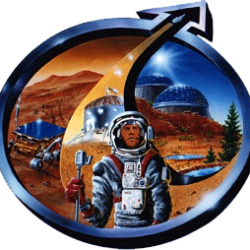CREW 315 SOL SUMMARY REPORT 30-04-2025
Sol: 10
Summary Title: Settling Into the Martian Embrace
Author’s Name: Urban Koi, HSO
Mission Status: Nominal. All systems operational.
Sol Activity Summary:
Sol 10 dawned upon Crew Phoenix with a familiar cadence, the hum of routine settling into our bones as surely as the red dust settles into the seams of our boots. Each morning, we rise in the same order (Commander, Crew Artist, HSO, Journalist/GreenHab Officer, Crew Engineer), a silent choreography that speaks of adaptation.
Crew Engineer and HSO carried on with their first EVA of the Martian morning, embarking on a journey that took the crew to the storied Overlook. The rover bounced vigorously beneath the HSO’s hands as they traversed the red wilderness, the terrain unfolding in waves of ochre and umber. The drive was one of the longer ones of our mission, a journey both physical and contemplative. With each mile, the world outside the viewport grew more profound, the silence of the desert vast and unbroken, save for the wind’s low song. At the Overlook, they paused—engine off, hearts open. Before them, mountains rose in solemn majesty, their ancient bones etched by eons of wind and memory. Crew Engineer set up his 3D scanning nook and got right to work on scanning more mysterious Martian rocks. HSO flew her drone and captured the mountains’ grandeur in a series of videos, each frame a testament to the beauty and solitude that define this place.
Next, they proceeded through Candor Chasma, a landscape alive with memory, the terrain etched by the ancient passage of water. Here, geology is a form of storytelling, and each stone whispers of epochs past. As they hiked, the wind carried the scent of desert plants and the promise of new questions. Each step was a reminder that Mars, even in simulation, is a teacher-demanding, humbling, and endlessly inspiring.
The land is dynamic, shifting, never quite the same from one sol to the next—a mirror to our own evolving sense of purpose. Upon returning, the Crew Engineer, HSO, and Crew Artist embarked on a half-EVA, seeking to bridge worlds through art. With drone photography and brush, they reimagined Alan Bean’s vision, placing our humble habitat into the lineage of explorers who have gazed at distant horizons and dared to dream.
Upon return to the habitat, the aroma of experimental strawberry bread, baked by the HSO, drifted through the habitat, another gentle reminder that comfort can be crafted even in the most alien landscapes. In the GreenHab, the Journalist/GreenHab Officer harvested a bounty of lush microgreens and herbs—150 grams of living green, a vivid defiance against the dry desert outside. Each sprout, each leaf, is a small act of hope, a promise that life, in all its tenacity, can flourish even here.
Crew Engineer (our very efficient Swiss Army knife) finally tamed the recalcitrant rear door—a mundane triumph, yet one that brings to light the truth of exploration: Progress is measured not just in grand discoveries, but in the patient solving of small, persistent problems. Dinner was a celebration of collaboration: chicken salad made by the Crew Artist, wrapped in tortillas lovingly made by the Crew Journalist, vegetarian pasta and chili for the HSO—meals that nourished both body and spirit of the crew.
As Sol 10 draws to a close, we gather in the habitat, our bonds deepened by shared challenge and wonder. Here, at MDRS, we are more than a crew—we are witnesses to the magic of space exploration, and each day is a stanza in the epic of our becoming. All hearts are full. The horizon calls, and we answer—settling into the Martian embrace one sol at a time.
LOOK AHEAD PLAN:
Anomalies in Work: None at this time.
Weather: Temperature: 71º, 0930; Sky: Cloudy, 0930; Gust: 0 mph; 0930; Wind: 5 mph, 0930
Crew Physical Status: All in Good Health + Spirits
EVAs to Be Completed:
EVA 20: 0900-1300
Purpose: To return rock samples collected at Robert’s Rock Garden for the 3D scanning project and further explore Candor Chasma based on results from EVA 19. At Candor Chasma, we shall search for more rock samples and perform more drone flight operations.
EVA Participants: Michael Andrews (Engineer), Urban Koi (HSO), Elena Saavedra-Buckley (Crew Journalist/GreenHab Officer)
Reports to Be Filed: Sol Summary, Journalist Report, Crew Photos, Greenhab Report, Operations Report, EVA reports, EVA Request(s)
Support Requested: Please kindly ensure that Starlink issues are resolved before 2:30 PM (Mountain Time) for important crew responsibilities tomorrow. Please and thank you!

